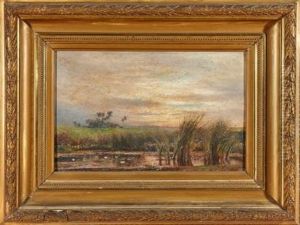Valentin Sanz Carta Paintings
Valentín Sanz Carta was a prominent Spanish painter, illustrator, and muralist, born in 1856 in Santa Cruz de Tenerife, Canary Islands. He is regarded as one of the most significant artists from the Canary Islands during the 19th century. Sanz Carta's work is characterized by its romanticism and detail, often focusing on historical and cultural themes related to the Canary Islands as well as religious motifs.
Sanz Carta received his initial art education in his native Canary Islands before moving to mainland Spain to further his studies. He studied at the prestigious Real Academia de Bellas Artes de San Fernando in Madrid, where he was influenced by the artistic movements of the time and honed his skills in painting and illustration. After completing his studies, he returned to the Canary Islands, where he became a key figure in the local art scene, contributing significantly to the cultural renaissance of the region.
Throughout his career, Sanz Carta was commissioned to create numerous works for public and private collections, including churches and public buildings. His murals and religious paintings are particularly noted for their vibrancy and emotional depth. In addition to his larger works, Sanz Carta also produced a significant body of illustrations for books and periodicals, showcasing his versatility as an artist.
Despite his success, Sanz Carta's life was marked by tragedy and hardship. He struggled with financial difficulties and personal loss, which are thought to have influenced the melancholic tone of some of his later works. Valentín Sanz Carta died prematurely in 1898, leaving behind a legacy that has continued to influence artists in the Canary Islands and beyond. His work remains celebrated for its contribution to Spanish art and its depiction of Canarian identity and culture.





